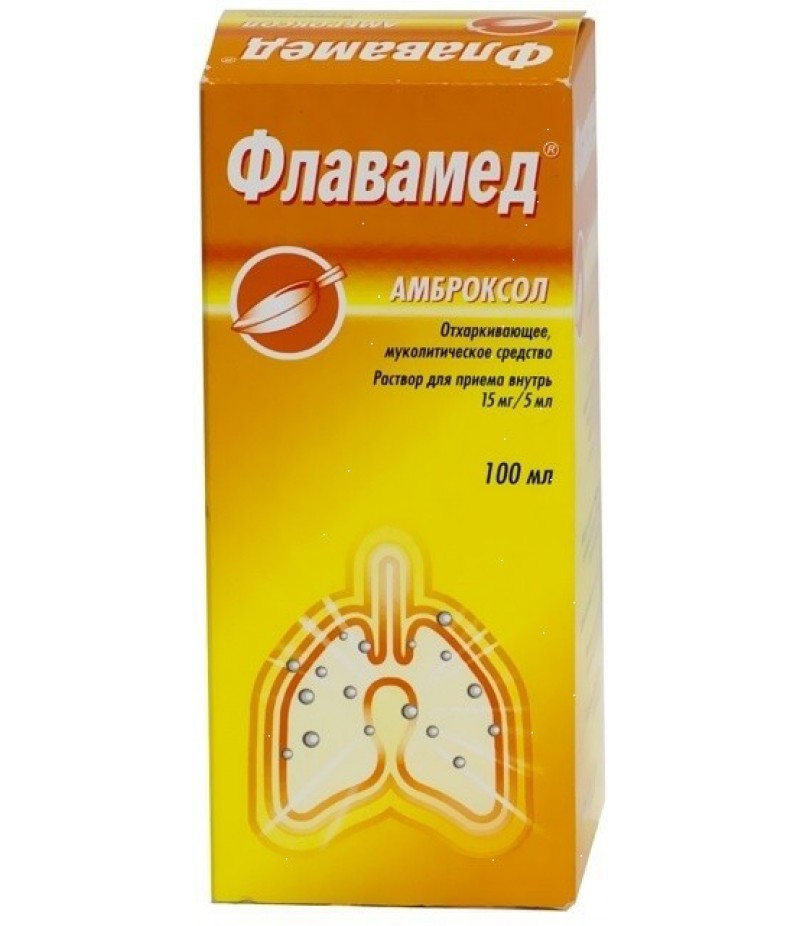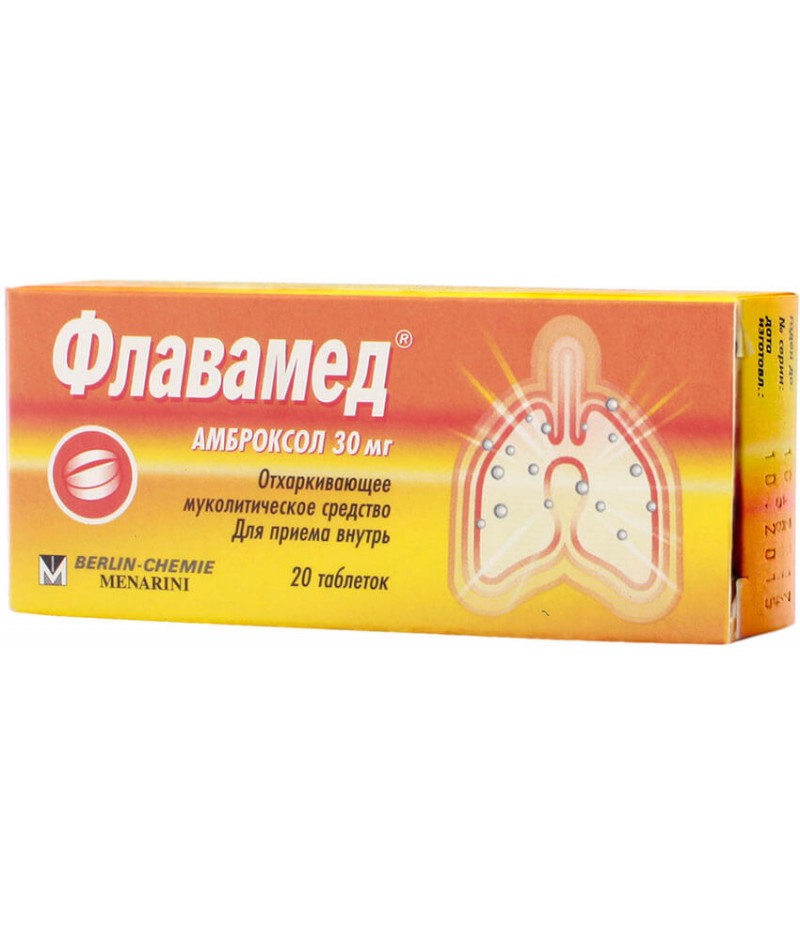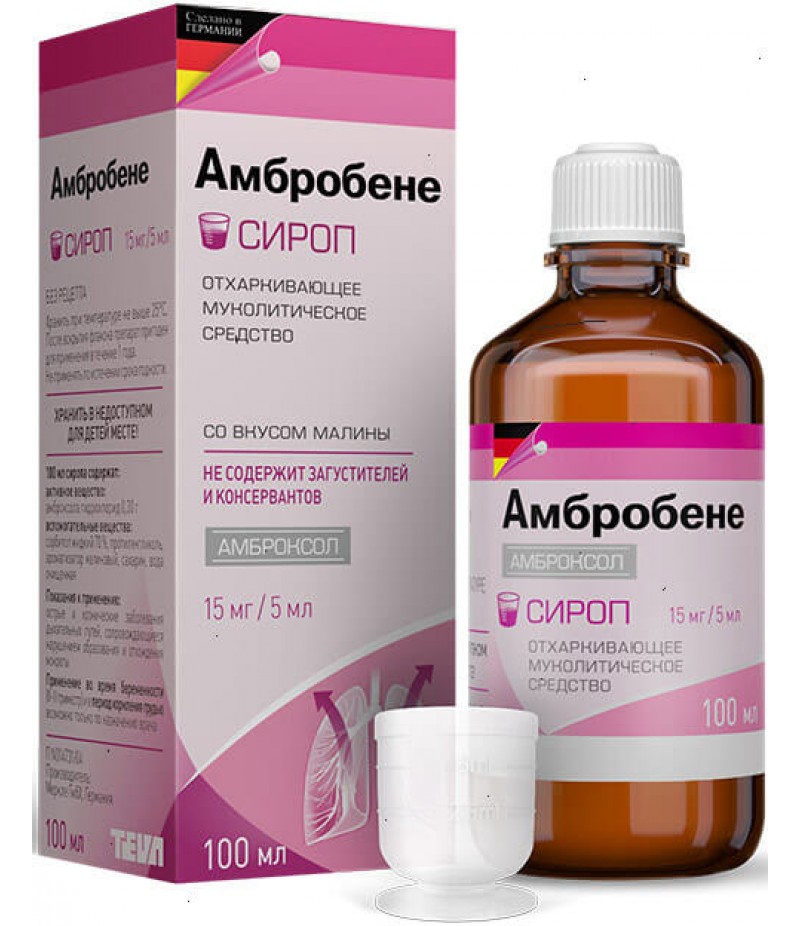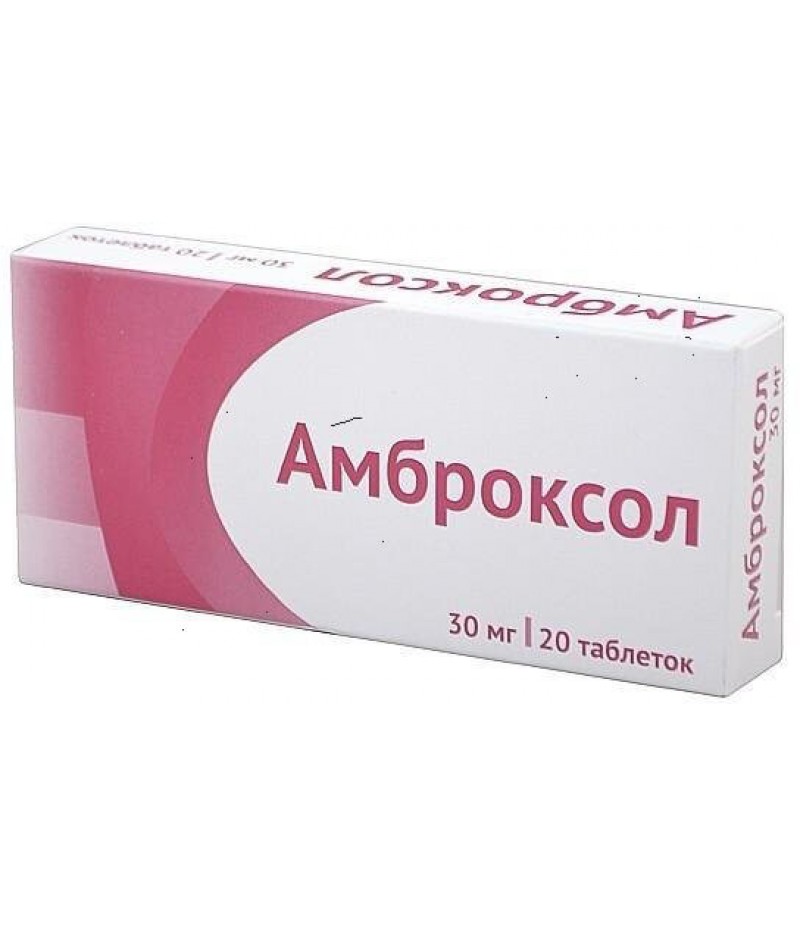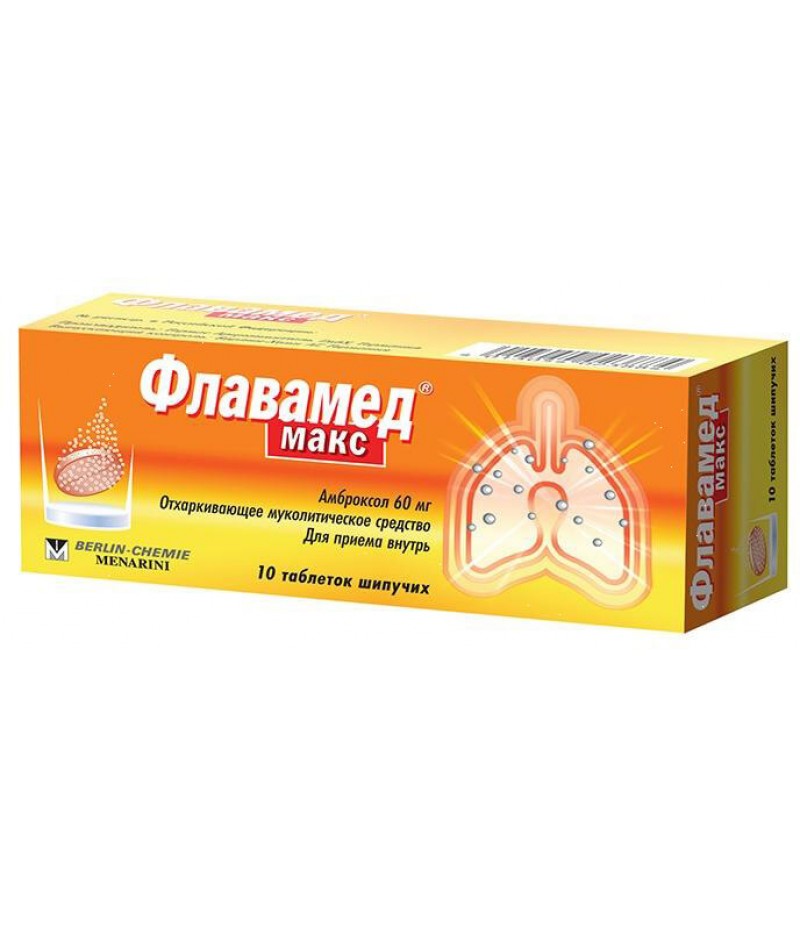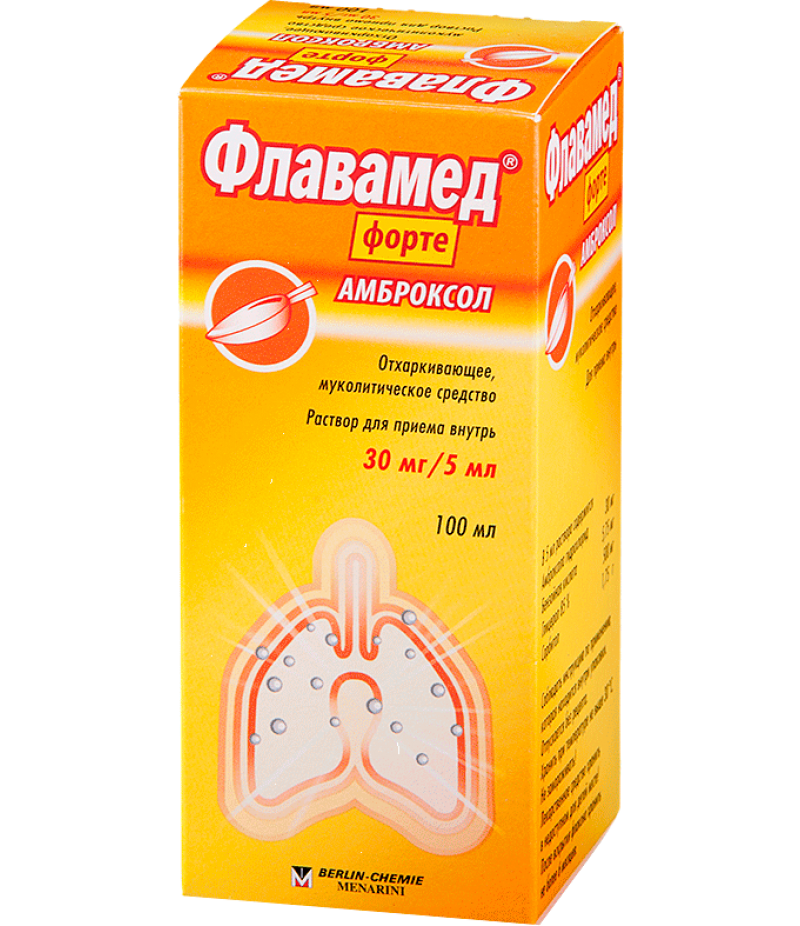Flavamed solution 15mg/5ml 100ml
- $14.30
- 3 or more $13.99
- Availability:In Stock
Flavamed solution instructionYou can buy Flavamed solution on this pageIngredientsIn one measuring spoon (5 ml) of the solution contains:Active substance: ambroxol hydrochloride - 15.00 mg;Excipients: benzoic acid, glycerol 85%, s..
Tags: solution
Flavamed solution instruction
You can buy Flavamed solution on this page
Ingredients
In one measuring spoon (5 ml) of the solution contains:
Active substance: ambroxol hydrochloride - 15.00 mg;
Excipients: benzoic acid, glycerol 85%, sorbitol 70% (non-crystallisable), hyetellose (hydroxyethylcellulose) (degree of molar substitution 2.5, average viscosity 6000 mPas), aromatizer raspberry No. 516028, purified water.
Description: transparent, colorless or brownish liquid with a crimson smell.
Pharmacotherapeutic group: Expectorant mucolytic agent.
ATX Code R05CB06
Pharmacological properties of Flavamed solution
Pharmacodynamics
Ambroxol is an active N-demethylated metabolite of bromhexine. Has a secreto-motor, secretolitic and expectorant action. Stimulates the serous cells of the glands of the bronchial mucosa, increasing the content of mucous secretions and, thus, changes the disturbed ratio of serous and mucous components of sputum.
Ambroxol increases the content of mucous secretion and the release of surfactant (surfactant) in the alveoli and bronchi. Increases the motor activity of the ciliated epithelium, increases the mucociliary transport of sputum.
On average, when taken orally, the effect occurs after 30 minutes, the duration of the action is 6-12 hours, depending on the size of the single dose.
Pharmacokinetics
Suction. After ingestion ambroksol quickly and almost completely absorbed from the gastrointestinal tract. The maximum concentration in the blood plasma (Cmax) is reached after approximately 1-3 hours. Absolute bioavailability of ambroxol when ingested due to the metabolism associated with the effect of the first passage through the liver decreases by approximately 1/3. The resulting metabolites (such as, dibromantranilic acid, glucuronides) are excreted by the kidneys.
Distribution. Binding to plasma proteins is about 85% (80-90%). Ambroxol penetrates through blood-brain and placental barriers, and is also excreted in breast milk.
Metabolism. Ambroxol is metabolized in the liver by conjugation with the formation of pharmacologically inactive metabolites.
Excretion. The half-life from plasma (T1) is 7-12 hours. T½ ambroxol and its metabolites (in total) is about 22 hours. It is excreted mainly by the kidneys - 90% in the form of metabolites formed in the liver. Less than 10% of the amount excreted through the kidneys account for the proportion of ambroxol in unchanged form. In severe violations of kidney function T1; metabolites of ambroxol increases, but does not change in severe liver diseases.
Due to the high degree of binding to plasma proteins and a large volume of distribution, as well as a slow reverse distribution from tissues to the blood, significant elimination of ambroxol by dialysis or forced diuresis should not be expected.
Indications for use
Acute and chronic diseases of the respiratory tract, accompanied by impaired secretion and transport of sputum:
acute and chronic bronchitis;
pneumonia;
chronic obstructive pulmonary disease;
bronchial asthma;
bronchiectatic disease.
Contraindications for Flavamed solution
Hypersensitivity to ambroxol or other components of the drug (see Composition);
congenital intolerance to fructose.
Carefully
violation of bronchial motility and the formation of secretions in significant amounts (for example, with a rare malignant cilia syndrome);
restriction of kidney function or severe liver damage;
children's age up to 2 years.
Application in pregnancy and lactation
The use of the drug in the first trimester of pregnancy is contraindicated. In the II and III trimesters of pregnancy, the drug should be taken with caution.
The use of the drug in lactation is possible only if the expected benefit of the treatment exceeds the possible risk.
Dosing and Administration
Solution for oral administration.
Unless otherwise prescribed, the following rules are recommended.
Children under 2 years: 2 times a day for 1/2-spoon (2.5 ml) solution Flavamed (corresponding to 15 mg ambroksola hydrochloride / day).
Children aged 2 to 5 years: 3 times a day for 1/2 teaspoon (2.5 ml) of Flavamed solution (corresponding to 22.5 mg of ambroxol hydrochloride / day).
Children aged 6 to 12 years: 2-3 times a day, 1 scoop of Flavamed solution (corresponding to 30-45 mg ambroxol hydrochloride / day).
Adults and children over 12 years: during the first 2-3 days, as a rule, 3 times a day, 2 scoops (10 ml) of Flavamed solution (corresponding to 90 mg of ambroxol hydrochloride / day), then 2 times a day day, 2 measuring spoons (10 ml) of the Flavamed solution (corresponding to 60 mg ambroxol hydrochloride / day).
If necessary, to increase the therapeutic effect, you can assign 4 measuring spoons (20 ml) of Flavamed solution 2 times a day (corresponding to 120 mg ambroxol hydrochloride / day).
When limiting kidney function or severe liver damage, the drug should be used with longer intervals between doses or in a reduced dose.
Flavamed solution is taken after a meal, using a measuring spoon. Duration of application is determined individually, depending on the indications and course of the disease. Without the appointment of a doctor, Flavamed should not be taken more than 4-5 days.
Side effects of Flavamed solution
Possible side effects are given below on the descending incidence frequency: sometimes (> 0.1%, <1%), very rarely (<0.01%), including individual reports.
Sometimes: reactions of hypersensitivity (skin rash, face swelling, shortness of breath, skin itching), hyperthermia. Very rarely: anaphylactic reaction.
From the side of the digestive system sometimes: abdominal pain, nausea, vomiting.
From the side of the skin is very rare: epidermal necrolysis, Stephen-Johnson syndrome.
Overdose
Symptoms: short-term anxiety, diarrhea, salivation, nausea, vomiting, lowering of blood pressure are possible.
Treatment: symptomatic therapy.
Interaction with other medicinal products
With the combined use of Flavamed solution and antitussive drugs that suppress the cough reflex, the danger of stagnant phenomena can arise due to the weakening of the cough reflex.
special instructions
In severe renal failure, it is necessary to consider the possibility of accumulation of metabolites of ambroxol formed in the liver (see Contraindications).
To maintain the secretolytic action of Flavamed solution during the period of taking the drug, it is necessary to ensure the intake of liquid in the body in sufficient quantity.
Note for patients with diabetes: in 5 ml of solution (1 measuring spoon) contains 1.75 g of sorbitol, which corresponds to 0.15 bread units (XE).
Impact on the ability to drive vehicles and manage mechanisms
Not installed.
Form of issue
Solution for oral administration 15 mg / 5 ml. For 60, 100 or 200 ml of the solution in dark glass bottles (type III), sealed with a screw cap.
For 1 bottle complete with a measuring spoon, along with instructions for use in a cardboard bundle.
Storage conditions
At a temperature of no higher than 25 ° C.
Keep the medicinal product out of the reach of children.
Shelf life - 3 years in the original packaging.
6 months after the first opening of the vial.
Do not use after the expiry date printed on the package.
Conditions of leave from pharmacies
You can buy Flavamed solution without recipe.

